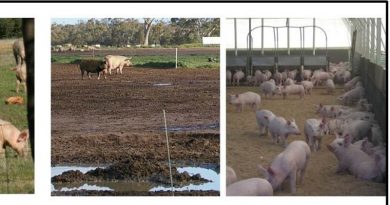Livestock farming on pasture is a responsibility not a right
Summary of submission by Patrick Francis to the Animal Industries Advisory Committee
In February 2016 I submitted a 24 page submission to the Victorian governments Animal Industries Advisory committee’s review into a presumed intensification of livestock farming in the state. The review is seen by many involved in more intensive pasture based livestock farming as a review into their right to farm livestock.
My full 24 page review is available as an e-zine on this web site.
Key points in my submission are:
- There is increasing market demand for fresh meats, dairy and eggs with credence values attached.
- Free range, natural, grassfed are increasingly popular credence values but are highly variable in interpretation on farm.
- Industry endorsed best practice methods exist for all pasture raised livestock except poultry – they are based on agricultural science and environmental science.
- Right to farm advocates are trying to establish a hybrid livestock raising system on pastures which sits between best practice grazing and intensive animal farming.
- Planning policy should embrace best practice grazing and environmental management methodologies for all livestock farming decisions.
- The bottom line is livestock enterprises on pastures must be undertaken in accordance with best practices. If implementation of best practices cannot be guaranteed with appropriate monitoring by farmers applying to increase production per hectare then planners should treat the enterprise as “intensive”.
- Hybrid systems between extensive and intensive are not best practice for either pasture grazing or intensive animal farming and cause problems for paddock ecosystem functions and animal welfare. They should not be accommodated in planning policy.
- Definition of “extensive ” livestock production should include adherence to best practice grazing and environmental guidelines as currently covered in dairy, beef, sheep, and pig industries. Poultry and horses on pasture can be accommodated by these guidelines.
- Proportion of animal’s diet provided on pasture should not be the basis for deciding between “extensive” and “intensive” livestock production. Pastured pigs, poultry and small paddock horses must be fed the majority of their diet as concentrate rations for welfare and productivity. If this is undertaken in accordance with best practice grazing and environmental guidelines there is little danger to the farm and adjacent environment.
- Local government planners need to add grazing best practice and environmental management to their skill set, or seek external input from those with these skills, when assessing livestock planning permits.
What are key principles for environmentally compatible pastured livestock in a variable climate?:
- Paddock stocking rate matches its carrying capacity year round.
- Paddock ecosystem functions are maintained and improving. Key ecosystem functions are: most rainfall infiltrates soil rather than runs off; soil held in place during rainfall and wind events; soil carbon is maintained and increased (if below benchmark); Biodiversity above and below ground is maintained and increasing (if below benchmarks).
- Paddock nutrient inputs balanced with paddock nutrient exports (once benchmark chemistry, biological and physical indicators are achieved).
- Paddocks have minimum 70% plant ground cover year round.
- Paddocks have minimum 50% perennial pasture plant composition.
- Paddocks maintain a minimum 1200kg herbage dry matter per hectare throughout the year irrespective of rainfall.
- Paddock and farm landscape amenity is maintained or improving (if previously degraded).
- Farm greenhouse gas emissions per hectare are declining with the objective of being greenhouse gas neutral.
The following six examples demonstrate the points made above.








